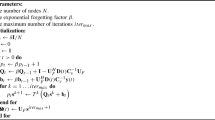Abstract
This paper presents two algorithms for on-line estimation of the optimal gain of the Kalman filter applied to sensor signals when the signal-to-noise ratio is unknown. First-order spectra of a pure signal and colored measurement noise have been assumed. The proposed adaptive Kalman filtering algorithms have been tested for various spectra of the pure signal and noise, and for various signal-to-noise ratios. The effect of the length of an adaptation step and a sampling frequency on the mean square errors of the pure signal estimation has also been examined. Although the test have been performed for stationary signals, the algorithms presented can also be used successfully for time-varying sensor signals when the signal-to-noise ratios vary very slowly in comparison with the length of the adaptation step.
The results are helpful for designers who synthesize optimal linear digital filters for sensor signals with first-order spectra and colored measurement noise. The estimation error curves presented enable designers to determine the noise reduction attainable for particular applications of the adaptive Kalman filtering algorithms.
Similar content being viewed by others
References
R. E. Kalman and R. S. Bucy, New results in linear filtering and prediction theory,Transactions ASME, Journal of Basic Engineering, Series D, Vol. 83, pp. 95–108, No. 3, March 1961.
B. D. O. Anderson and J. B. Moore,Optimal Filtering, Englewood Cliffs, New Jersey, Prentice-Hall, 1979.
A. Gelb,Applied Optimal Estimation, Cambridge, Massachusetts, MIT Press 1974.
G. F. Franklin and J. D. Powell,Digital Control of Dynamic Systems, Reading, Massachusetts, Addison-Wesley, 1981.
J. Z. Sasiadek and P. J. Wojcik, Tactile sensor signal processing using an adaptive Kalman filter,Proceedings of the 1987 IEEE International Conference on Robotics and Automation, March 30–April 3, 1987, Raleigh, North Carolina, Vol. 3, pp. 1753–1759.
P. J. Wojcik, On the design of an adaptive Kalman filter for on-line processing of sensor signals,Proceedings of the 26th IEEE Conference on Decision and Control, December 9–11, 1987, Los Angeles, California, Vol. 2, pp. 1605–1611.
G. C. Goodwin and K. S. Sin,Adaptive Filtering Prediction and Control, Englewood Cliffs, New Jersey, Prentice-Hall, 1984.
W. D. Stanley, G. R. Dougherty, and R. Dougherty,Digital Signal Processing, Reston, Virginia, Reston Publishing, 1984.
R. K. Mehra, On the Identification of variances and adaptive Kalman filtering,IEEE Transactions on Automatic Control, Vol. 15, pp. 175–184, No. 2, April 1970.
R. K. Mehra, An algorithm to solve matrix equations PHT=G andP=ΦPΦ T+ΓΓ T,IEEE Transactions on Automatic Control, Vol. 15, p. 600, No. 5, October 1970.
S. Middelhoek and A. C. Hoogerwerf, Smart sensors: when and where?,Sensors and Actuators, pp. 39–48, No. 8, 1985.
Author information
Authors and Affiliations
Rights and permissions
About this article
Cite this article
Wojcik, P.J. On-line estimation of signal and noise parameters with application to adaptive Kalman filtering. Circuits Systems and Signal Process 10, 137–152 (1991). https://doi.org/10.1007/BF01183767
Received:
Issue Date:
DOI: https://doi.org/10.1007/BF01183767




